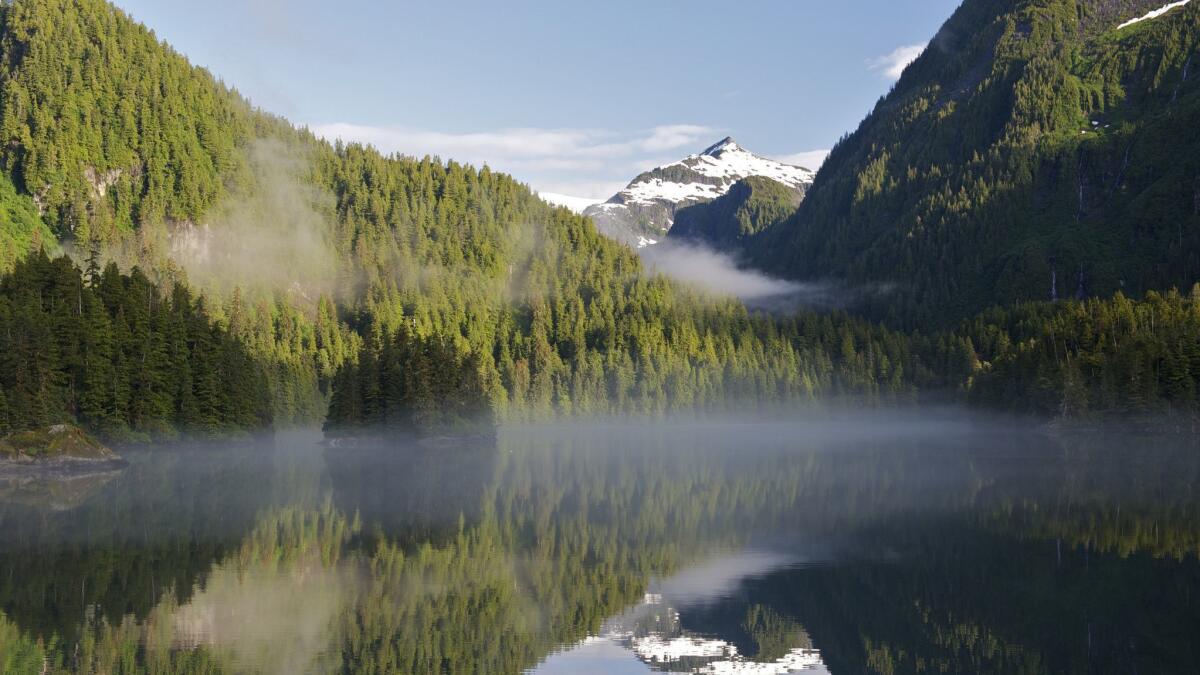Editorial: Alaska wants more roads in the Tongass National Forest. The answer should be no

- Share via
The Tongass National Forest, the world’s largest intact coastal temperate rain forest, covers some 17 million acres of southeast Alaska, where it provides near-pristine habitat to an astonishing range of wildlife. According to the National Audubon Society, loggers over the decades have felled more than 90% of the old-growth Hemlocks and other trees, many dating to before Europeans arrived in North America. Since 2001, the federal government has barred most new roads from being cut in more than 9 million acres of the Tongass under the ”roadless rule” adopted to preserve specific forestlands from destructive human incursions and increased logging. But the Trump administration now is considering exempting the Tongass from the roadless designation. Why? Because Alaskan government officials asked for it.
The answer to that request should be an emphatic, “No.”
Similar to arguments by Republican officials in Utah and other Western states, Alaska Gov. Bill Walker argued in announcing the request this year that restrictions to access imposed by the roadless rule had “harmed our ability to develop our resources.” He added, “Alaskans are the ones best positioned to determine responsible development.”
It makes no environmental sense to exacerbate the problem by logging more areas of the forest.
No, they are not “best positioned” when the land at issue is federal land held in trust for all of us, and it just happens to lie within the state’s boundaries. This principle isn’t unique to Alaska. Californians should no more get to determine how federal lands are used here than Utah residents can decide how to manage federal lands there. State and local officials should be consulted in the drafting of management plans for federal lands, but ultimately the decisions must be based on what is in the best interests of the American people at large.
As it is, the federal government manages its lands in a variety of ways, depending on how the land is categorized. National parks, which preserve some of our most spectacular natural areas, enjoy some of the most restrictive governance. Other federal lands can be designated for multiple uses, including leasing for cattle grazing, logging, mining and other extractive industries. National forests are managed lands that, depending on the details of their management plan, can be logged or mined in addition to supporting recreation and other non-extractive uses. But the Tongass is unique among them, and the areas of it under contention now should be left alone.
The drive to open ever more federal lands for logging, mining and other uses that extend the footprint of human development into the natural world puts the profits of private logging and mining companies ahead of the interests of other economic sectors, particularly tourism, fishing and recreation. Headwaters Economics, a nonpartisan research organization based in Montana, reports that the Tongass region’s salmon industry employs 4,300 people, compared with about 165 timber-related jobs, yet allowing new roads into the forest, and the tree-cutting that could follow, could endanger the salmon habitat and some of the jobs that it supports. The U.S. Department of Agriculture, which manages the national forests, spends more than a third of its Tongass National Forest budget supporting the logging industry; from 2009-13 the government spent an average of $771,000 per year processing permits and other support efforts for an industry that only brought in $59,000 per year in federal revenue.
Enter the Fray: First takes on the news of the minute from L.A. Times Opinion »
Beyond the bad economics of adding roads and expanding logging in the Tongass, scientists argue that the forest absorbs the equivalent of about 8% of the U.S. annual greenhouse gas emissions, and that cutting old growth also releases up to two-thirds of the trees’ stored carbon into the atmosphere. The Tongass already is suffering from the impacts of global warming as rain patterns change and glaciers recede. It makes no environmental sense to exacerbate the problem by logging more areas of the forest.
This is not the first time Alaska has sought an exemption; an earlier one was shot down by the courts, and legislative efforts also have failed. Still, the proper fix here rests in Congress’ hands: It should begin the process of converting the Tongass National Forest into a national park, on footing with Yosemite, Yellowstone, Death Valley and other areas of natural wonder that have been set aside since 1872. At a minimum, the government ought to back off this latest effort to hand over our common heritage for exploitation by special interests, and work to increase protections for this embattled region.
Follow the Opinion section on Twitter @latimesopinion or Facebook
More to Read
A cure for the common opinion
Get thought-provoking perspectives with our weekly newsletter.
You may occasionally receive promotional content from the Los Angeles Times.






